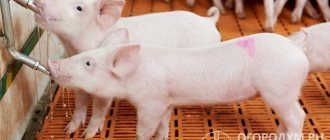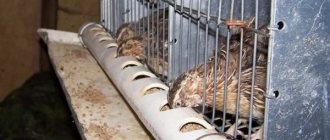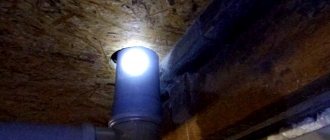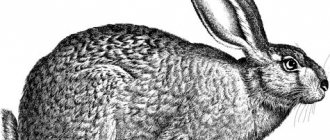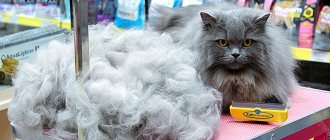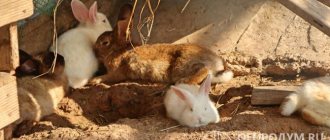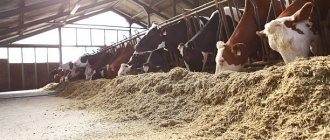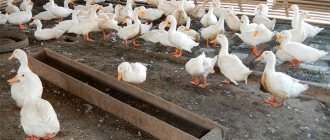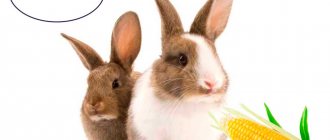Rabbits are extremely active and mobile animals. Therefore, using ordinary shallow bowls, plates and boxes as a feeder risks the fact that some of the food is constantly scattered throughout the cage, stuffed into the cracks of the floor, trampled into the dirt and bedding. In addition, such living creatures eat frequently, which is why it is necessary to constantly check the container for the presence of food. But when using a bunker feeder for rabbits, animal owners are able to solve both problems, significantly saving time in caring for animals, and reducing the consumption of feed supplies.
Hopper feeder
Requirements for feeders
Before purchasing devices, you need to take into account their indicators, which will help organize a rational feeding process:
- the correct volume of the feeder (should accommodate the daily portion of feed);
- ergonomics (convenient to pour food, easy to remove for cleaning and disinfection);
- safety for animals (high-quality material of construction, absence of sharp corners, notches);
- impossibility of getting animals, garbage, feces inside.
You can use different designs at the same time, matching them to the products.
Advantages of bunker feeders
Rabbits are extremely active pets. They constantly move, eat frequently, and react acutely to any changes in the environment. If the breeding of animals is carried out in closed cages, then this imposes certain restrictions on the process of providing the animals with food and water. Moreover, if an ordinary flat container is suitable for feeding grass, branches and vegetables to rabbits, then when using bulk feed, a bunker feeder has a number of advantages over a regular one. These include the following:
- More economical feed consumption. After eating, the rabbits begin to walk around in their cages. Typically, this process will immediately turn plates and bowls over. In addition, at certain periods of life, such animals can behave aggressively and deliberately kick drinking bowls and feeders in their house, throwing them against the walls, grabbing them with their teeth. The animal will not be able to turn over the bunker container, nor will it be able to throw the food out of it.
- Minimizing time spent on feeding. In the wild, rabbits eat up to 80 times a day. Therefore, they should also be fed frequently in the cage. But if in the case of ordinary containers it is necessary to constantly replenish it, then it is enough to pour food into the bunker feeder once every few days.
- Keeping food clean. When using flat containers, food often gets dirty. Rabbits may scatter it in the dirt, or animal droppings may fall into it. As a result of eating such food, the rabbit's risk of disease increases sharply. But the hole in the bunker feeder is quite small, and the design eliminates the possibility of contamination of bulk feed.
- Ease of maintenance. Despite the functionality of this design, it is designed quite simply. Therefore, cleaning is easy and does not take much time.
- Easy to install. Such food containers can be easily installed on any type of cage. In addition, the main part of the product is mounted outside, which does not reduce the already small amount of space. This means that the animal will have more space to walk, which also has a positive effect on its condition.
Important! As a result of using this design, the animal eats plenty. At the same time, the quality of the feed always remains unchanged, and the risk of developing diseases of the digestive system is reduced to a minimum.
Main types of feeders
- Bunker models. A practical container that is suitable for dry granulate and grain. In essence, this is an automatic feeder in which food is supplied automatically as it is eaten. The animals have unhindered access to the dishes, making it convenient to eat from them.
There is no need to check that the tank is full, because its volume is designed to last for a long time. The designs are ergonomic - easy to fill and clean. You can buy it or make it yourself using galvanized steel using special drawings. - Nursery devices. A manger or hay barn for rabbits is a popular design that is made from wood or metal. Used for hay or grass - prevents their scattering. Senniks can be placed both inside the rabbitry and from the outside. It is not advisable to attach the sennik to the cage door so that the baby rabbits cannot get in and be injured.
- In the form of cups. Such dishes are suitable for feeding juicy and dry foods. Stores offer ceramic or plastic cup designs. Due to the fact that rabbits often turn them over, they are not practical enough in practice. Bowls can be easily made independently from scrap materials (tin cans, plastic bottles, concrete pours).
- Grooved. Chutes are used for all types of products. Animals have unimpeded access to such reservoirs, especially during collective breeding. Minus - they easily turn over, feces, bedding, and dirt can get into them.
- Models for root crops. Cup containers are best suited for feeding succulent feed, but trough options can also be used.
- Universal devices. This group includes bowls, gutters, and self-made models. The advantage of this variation is the ability to feed different types of feed at the same time.
- Other models. There are different types of industrial feeding containers that differ in appearance, quality, and cost.
Step-by-step production
We invite you to familiarize yourself with step-by-step instructions for constructing the most popular types of feeders.
Cup
Any container with smooth edges will do for this. The main thing is to secure the feeder well in the cage, otherwise the animals will constantly knock it over.
You can take any container as a container for food - a bowl, a jar, a basin, but in such containers the food quickly becomes dirty and often scatters throughout the cage.
Experienced rabbit breeders offer several simple methods of attachment:
- hang on the cage wall using wire or hooks;
- screw it to the floor (which is not very practical, as it complicates the cleaning process).
Bunker
The simplest version of a bunker feeder is a product made from wooden sheets covered with tin.
To make such a container you need:
- Following the drawings, make markings on sheets of iron and plywood, cut all metal and wooden parts (bottom, walls, load-bearing cross member) along the contour.
- Tin parts are bent by hand.
- Wooden parts are fastened to sheets of metal.
- Then all the parts are knocked together.
Drawing of one of the cutting options indicating the dimensions of all parts
The creation process can be organized much easier if you do without the use of plywood. To do this, it is advised to prepare a test layout from paper, fold it and check that there are no gaps or protruding parts. Then the drawing of a bunker feeder for rabbits is transferred to a galvanized metal sheet, no more than 0.4-0.7 mm thick, all the parts are cut out and fastened together using rivets.
If you have all the necessary consumables, making such a design will take no more than 2 hours.
The following video presents the simplest and fastest option for manufacturing a bunker-type device:
From a canister
An old, well-washed canister will serve as a convenient container for grain and granulated feed. In addition to the canister itself, you will need a knife, a block, screws, wire, plywood and tin.
Procedure:
- mark and cut out places on the canister for two holes (for pouring food and delivering it to the rabbits);
- saw off a block slightly longer than the bottom opening, insert it into the workpiece and secure it with self-tapping screws - you will get a feed stop;
- make a rectangular partition from a sheet of plywood to form a grain bin;
- cut out the side holders for attaching the partition from the block, secure them at an angle using screws to the base of the product;
- make cuts in the upper opening of the canister, insert a piece of plywood into them, pull it to the side walls using self-tapping screws;
- cut a strip of tin, bend it and screw it to a wooden stopper so that rabbits don’t gnaw it;
- hang the finished product on the cage using wire directly on the mesh.
In the photo there is a feeder for rabbits: a convenient and practical container for grain, created from an ordinary plastic canister
According to the Maklyakov method
Another popular type of bunker-type structure, which is made of galvanized iron (or plywood) using the following technology:
- Markings are made on a sheet of metal in accordance with the drawing, side and internal walls, a lintel and a supporting strip are cut out.
- After this, the necessary bends, holes for connections are made, as well as several holes in the floor so that small debris and dust fall down.
- All parts are fastened with rivets.
Rabbit farm equipped with bunker feeders of the Maklyak system
This type of feeder is in demand among rabbit breeders not only because it is one of the most affordable options, but also due to its high practicality - if there are two bunkers, it is possible to fill several types of feed at once.
Grooved
This feeder is designed for simultaneous feeding of animals, suitable for any type of feed - green, coarse and concentrated, and can also be used as a drinking bowl. It is made from 50 cm in length (1 m is considered optimal) from metal, wood or other suitable materials.
When starting work, you must first decide on the material for the structure, study the diagrams and drawings. For example, to create a wooden product, 6 boards are taken - 2 for the longitudinal walls, 4 for the ends.
The simplest and most practical option for making a groove feeder yourself is to use plastic pipes (It is important to carefully align the edges of the cuts so that the animals do not get hurt.)
The easiest way to produce a grooved structure with your own hands is to take a piece of plastic or metal pipe with a diameter of 100-150 mm. It needs to be cut lengthwise and the sides closed to prevent feed from spilling out.
It is also easy to build a bunker-type structure from a pipe
Zolotukhin systems
Trough feeders made according to Zolotukhin’s drawings are very popular among rabbit breeders. Their advantage is that the structure is inserted directly into the door and is often equipped with rotating mechanisms. This is very convenient, as it saves space in the cage, and there is no need to open the door every time to add food or clean the container.
The procedure is as follows:
- cut out two wooden sides;
- make marks on a metal sheet;
- bend the sheet metal along the marked lines;
- fasten the side parts to the metal blank with self-tapping screws.
Zolotukhin’s drawings: a – trough feeder made of wooden boards; b – trough drinker; c – nursery (sennik)
Nursery
There are many options for creating hay barns. Let's consider the simplest of them, for the manufacture of which you will need wooden boards, a sheet of iron, a drill, a saw, nails and screws.
- The sides are made from boards, which should expand at the top and smoothly taper towards the bottom.
- The main part of the hay bar is cut out of galvanized sheet, and its edges are bent.
- Wooden and metal parts are fastened together using self-tapping screws.
- To hang the finished product, galvanized iron strips about 10 cm long should be attached to it.
The dimensions of the hay barn are selected individually, taking into account the parameters of the cage and the needs of its inhabitants.
Nursery feeder made at home from wooden beams and coarse mesh
Another original idea for creating a hay box from scrap materials is a plastic box with holes cut in the bottom and one of the sides
Materials and tools for making feeders yourself
Making a device with your own hands is not difficult. You just need to stock up on materials for manufacturing and tools with which it will be convenient to make such structures. Before work, you will need diagrams of future products with dimensions.
| Materials | Tools |
| Wooden boards, plywood sheets Flat slate sheets PVC pipes (plastic) Sheet of metal (preferably stainless steel) Roll of wire Metal mesh of different sizes Plastic canister Plastic bottle | File Self-tapping screws (nails) Pliers Wire cutters Hammer Screwdriver Drill Tape measure Pencil Scissors Stationery knife Rivets Pliers File |
Important points
Before you start making a homemade feeder, you need to take into account a number of rules to make it convenient for the rabbits to eat and for the owner to clean up:
- If the product is not made of metal (or galvanized), then it is necessary to immediately eliminate the risk that the animal will gnaw on the surface.
- The size of the feeder must be optimal for the amount of food that is intended for the animal per day. If the container is larger in size, then the rabbits will begin to climb into it and pollute the cage with food.
- It is quite important to pay attention to the fact that there are no small burrs or sharp corners along the edges, otherwise the rabbit will easily get a splinter or get hurt.
- It is necessary to provide in advance so that the container can be securely fixed to the wall or to the floor, otherwise the rabbits will easily turn it over.
- It is necessary to accurately calculate the size of the feeder, taking into account how many animals will feed in it.
- The container must be easy to clean. In this case, metal structures are best suited.
Valuable tips for building feeders at home
Before you start manufacturing bunker feeders for rabbits according to the drawings, you should take into account the following recommendations:
- all components of cage arrangement, including feeders, should be as convenient as possible in maintaining cleanliness and hygiene;
- if the feeder is made of thin materials that can be chewed by rabbits, then it is necessary to cover the edges of the feeder with tin for its longest service life;
- It is recommended to arrange the feeders so that the food is contaminated as little as possible (drill holes in the bottom of the feeder, or line the bottom with a fine grid);
- the volume of feeders must be no less than the daily feeding rate for rabbits, otherwise the animals will climb into them and mess up;
- Attachments of feeders to cages should be as strong as possible to prevent them from overturning.
The growth rate of rabbits directly depends on the quality of feeding.
A creative approach to breeding eared pets will make rabbit breeding a very interesting activity. If you build cages and feeders for rabbits with your own hands from scrap materials, you can save an impressive amount before starting a rabbit breeding business.
Construction rules
The right feeder for rabbits has the following characteristics:
- convenient for pouring food and regular cleaning;
- optimal volume. A feeder with a low capacity makes life difficult for the owner (you often have to add a nutrient mixture) and leads to underfeeding of the rabbits. Their appetite should not be underestimated: each day each one applies itself to the feeder up to 30 times. Animals climb into an excessively large container, scattering food and soiling it with feces;
- there are holes in the bottom or it looks like a fine mesh. This measure prevents contamination of the feed;
- simultaneous access to food for all inhabitants of the cage. With limited feeder sizes, strong rabbits push aside weak ones and they suffer from malnutrition. But when selecting sizes, it is again important to prevent animals from getting inside (see rule No. 2);
- there are no sharp edges or piercing elements that could injure animals;
- The material is resistant to pets' teeth and does not harm them. Rabbits excitedly gnaw not only food, but also what they are not supposed to gnaw: parts of the cage (even metal mesh), trays and, of course, the feeder.
It’s worth talking about materials for feeders in detail.
Why plastic pipes?
All owners of chickens, turkeys, quails, ducks and other poultry are faced with the problem of uniform feed distribution. It is unprofitable to devote a large area to the feeder, and in the bowl the food turns out to be unevenly distributed: hens and chicks randomly crowd each other, interfere with weaker individuals, and, in addition, trample on the feed.
The best shape for the product is a container that is long but narrow. This option takes up a small area and provides better access to food for chickens and quails. Previously, such containers were made of tin, but today there is a material that is more affordable and more consistent with the necessary requirements.
A bird feeder made from a plastic pipe has many advantages:
- the material is not afraid of moisture, so it is well suited for both food and water;
- plastic is hygienic - it does not promote the growth of bacteria and is not prone to mold;
- the initial “raw materials” – plastic pipes, have a more than affordable cost;
- the range of materials - wall thickness and diameter, cannot be described;
- making it yourself takes a minimum of time, does not require experience and allows you to build structures for both turkeys and rabbits, in accordance with the size of the latter.
The only disadvantages include less durability compared to particularly durable steel and cast iron products.
Dimensions
The volume of the bunker is calculated using the simple formula V = A * B * C, where:
- A is the daily feed requirement for one rabbit;
- B - number of pets;
- C is the number of days for which the feeder is designed.
The dimensions of the bunker are arranged so that it fits well into the cage and is located as rationally as possible. If the cell is to be divided in two, the bunker can act as a partition.
Sometimes it is made elongated and used as one of the outer walls. But with this design, there is no possibility of dismantling the feeder for repairs and cleaning of remnants of old food, and this is sometimes required.
Drawing of a bunker feeder
The dimensions of the tray are selected so that all rabbits have simultaneous access to food. Otherwise, strong individuals will constantly push aside the weak ones and they will get sick from malnutrition. The tray of the bunker feeder cannot have any length - the grain pours out of the tank over a limited distance.
Therefore, with a significant number of livestock, they install a battery of several devices or make a couple of holes in the bunker on opposite sides and equip it, respectively, with two trays.
In cages with small rabbits, the maximum width of the hopper outlet opening is 2 cm. Through a larger one, the young animals will crawl inside and stain the food with feces.
Video on the topic
How to make a rabbit feeder with your own hands in the video:
Rabbits should be given food not only in sufficient quantity, but also in such a way that it remains clean and dry at all times. For this, a variety of feeders are used, many of which, following the recommendations given in this article, can be made independently.
When raising rabbits, it is important to have a good feeder. They eat often and a lot, so this process must be arranged practically. You can make your own rabbit feeders. Their models will differ in material, shape, and method of feeding. The right options will reduce food loss during feeding and help keep cells clean.
Device
The bunker feeder consists of two components:
a vertical tank in the form of a box with a rectangular cross-section or a round pipe - a bunker. A socket is welded onto the top of the pipe for ease of loading feed. For this purpose, the front wall of the box is made sloping outward. There is a narrow opening at the bottom of the hopper. The container can be equipped with a damper that regulates the amount of food spilled out. A lid is installed on top of the hopper to prevent rodents, insects from getting inside, and if the hopper has a neck that goes outside (easy to load), then also from precipitation. Due to the loose fit of the lid or the installation of ventilation holes protected by a mesh, ventilation of the internal space is ensured, which eliminates moisture condensation in the bin and grain rot. This is especially important during the cold period, when steam condenses intensively on the cooled walls;- dispensing chute or tray. Installed under the bunker. Grain spills into the tray from the hopper until there is a fairly large mound that blocks the hole. While eating the food, the rabbits open the hole and some grain is poured back into the tray. The bottom of the tray is made of fine mesh or many holes are drilled in it. This is necessary to drain condensate and sift out grain flour. In order to prevent feed from spilling out, the sides of the tray are folded (tin products) or equipped with slats.
The bunker feeder is suitable for the following feeds:
- grain mixtures;
- compound feed;
- various granular additives.
The diet of rabbits is not limited to this, so other feeders will be required:
- for root crops and mash: trough or cup feeders;
- for hay and forbs: nursery feeder (haybox).
Feeder from a sewer pipe
This rabbit feeder is easy to make. A rabbit feeder is made quickly and at no extra cost.
Video of making a feeder from PVC pipe
Drawing conclusions, we can say that rabbits will be satisfied with the presence of a triangular container in which the owner will put roughage. And you can connect a bunker to it, from which dry food will be supplied. Whatever the feeder, in addition to functionality, it is necessary to make it safe. Maintaining good hygiene will help raise healthy animals.
What types of hay feeders are there?
For a more comfortable stay for animals, the cage or enclosure must be equipped with everything necessary. These are not only feeders, drinking bowls or nesting houses. An equally important attribute is the presence of a hay field. If you don’t plan on expenses, you can refuse to purchase a hay feeder and make it yourself.
The importance of the sennik is as follows:
- animals often scatter hay throughout their living space. As a result, it is mixed with sawdust. The sennik will help maintain cleanliness in the enclosure;
- Rabbits can be picky and eat only the tastiest blades of grass. You will have to take out the hay from the feeder one twig at a time, which means that the animal will be deprived of choice and will have to eat everything;
- when kept in an enclosure, the dominant individual can climb onto a pile of hay and keep other rabbits away from the food. The same thing happens in cages where several animals are kept. Sennik allows all inhabitants to be in the same conditions;
- Using a hay box, you can train animals to relieve their natural needs in one place. Rabbits have a specific digestive system. When chewing begins, the intestines are activated. The hay feeder is installed in the right place, which helps maintain cleanliness in the room.
The convenience of a hay box is that you can put enough hay in it that it will last for several days. For example, if the owner leaves on business, food is provided in the required quantity.
The use of hay feeders is convenient not only if you keep one animal, but also for industrial breeding. It is not always possible to choose a convenient option in the store, but if you model it yourself, the hay tree will have the required size and shape.
There are two types of hay feeders:
The second type is attached to the mesh side of the cage, where it will be convenient for both the owner and the animal. In the case of an enclosure, the hay barn can be placed on one of the walls, placing it at the desired height, the main thing is that the rabbits can easily get food.
If the cage has the required dimensions, then the feeders are installed inside. The main thing here is to take care of the convenience of placing food in the container. To do this, make additional holes or build a hanging-type feeder.
Advantages and disadvantages of the design
The advantages of such a feeder include ease of assembly. It only takes 10 minutes to make a box. It can be made from available materials. To make a wooden feeder you will need:
- five boards of different heights;
- two side boards in the form of a trapezoid;
- hammer and nails.
Another advantage of the front opening design is the reduction of wasteful feed. The main distinguishing feature of a box feeder from a trough-shaped feeder is that the rabbits will not be able to scoop out the pellets from the box and get into it, so all the food will be used for its intended purpose.
The disadvantages of the feeder include the fact that the structure cannot be attached to the wall. To fill the box with food, the feeder must be turned over. If the feeder is intended for a small number of rabbits, then this drawback can be neglected.
If you have a large number of rabbits, it is better to add a hopper attachment to the wide box for easy filling with food. Such a nozzle can be made from plastic pipes.
Animals actively chew everything, so you need to give them young tree branches.
To prevent rabbits from chewing on a wooden feeder, tape around its edges and ends with metal construction tape.
